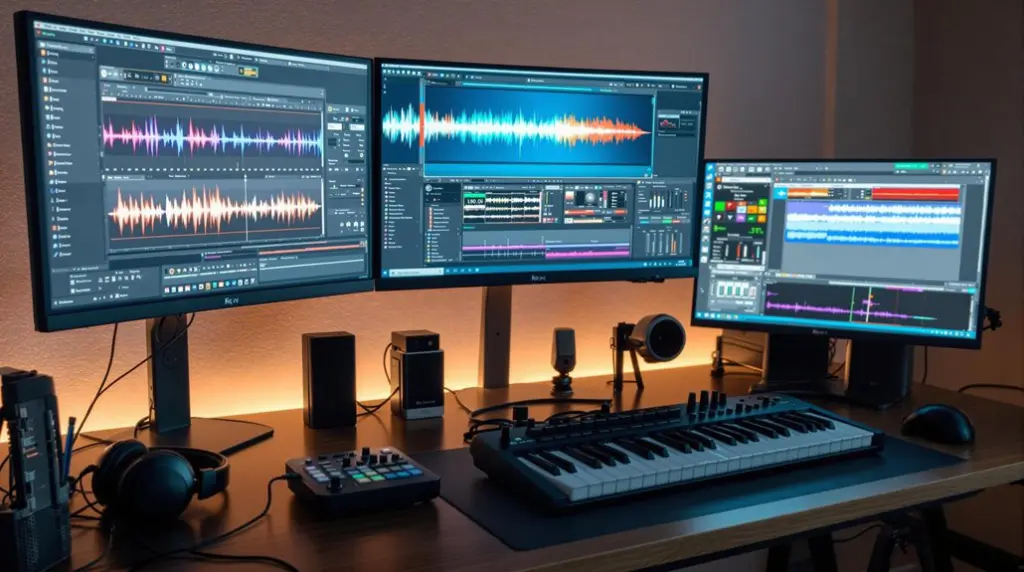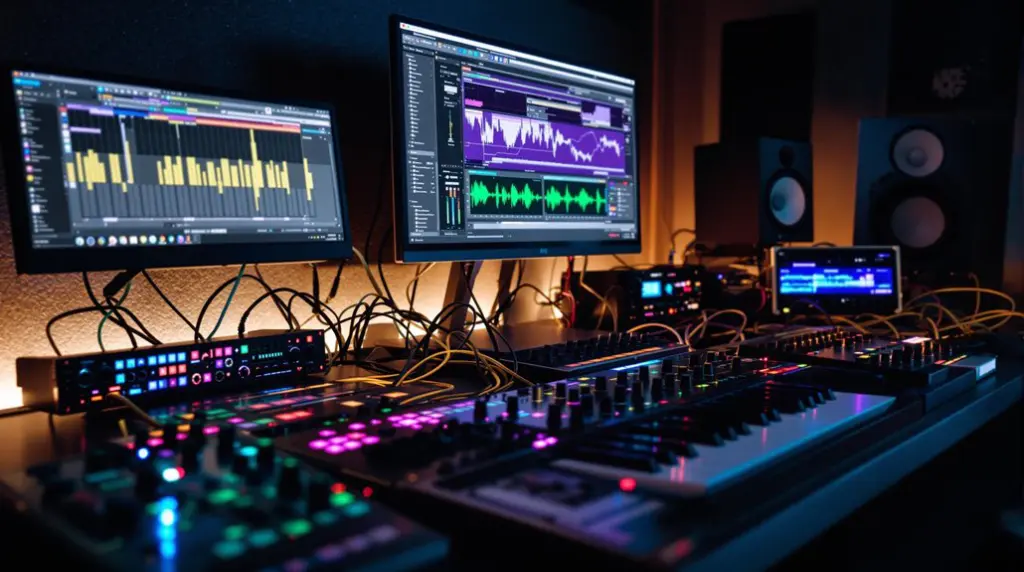In the domain of professional audio production, selecting an interface that guarantees zero-latency performance is essential. Among the top contenders are the Focusrite Scarlett 2i2, RME Babyface Pro FS, Universal Audio Apollo Twin X, PreSonus Quantum 2626, and MOTU UltraLite-mk5, each offering unique features tailored to meet the sophisticated demands of professional musicians. From the Scarlett 2i2’s acclaimed Air mode to the Apollo Twin X’s robust onboard DSP processing, these interfaces promise unrivaled audio quality and seamless real-time monitoring. Understanding what sets these models apart is vital for musicians aiming to optimize their studio workflows.
Key Takeaways
- RME Babyface Pro FS: Offers ultra-low latency performance and pristine audio capture with high-quality preamps.
- Universal Audio Apollo Twin X: Provides zero-latency monitoring and real-time effects with onboard DSP processing chips.
- PreSonus Quantum 2626: Ensures zero-latency monitoring through Thunderbolt connectivity with 26 inputs and outputs.
- MOTU UltraLite-mk5: Features zero latency, powerful onboard DSP effects, and seamless MIDI connectivity.
- Focusrite Scarlett 2i2: Excels in low-latency performance with high-fidelity converters and versatile combo inputs.
Focusrite Scarlett 2i2
The Focusrite Scarlett 2i2, a flagship model in the Scarlett series, is renowned for its exceptional preamps and high-fidelity converters, making it an indispensable tool for professional musicians and home studio enthusiasts. This audio interface offers two versatile combo inputs that accommodate both microphone and instrument inputs, providing flexibility in various recording scenarios.
The latest 4th Gen model features an enhanced Air mode, which enriches high-frequency detail, thereby elevating the overall clarity and presence in recordings.
When it comes to audio recording techniques, the Scarlett 2i2 excels with its low-latency performance, allowing real-time monitoring and seamless integration into complex recording setups. The device’s bus-powered design further adds to its convenience, enabling on-the-go recording without compromising on quality.
Signal routing is streamlined, ensuring that the signal path remains clean and transparent, which is crucial for capturing pristine audio.
In terms of software compatibility, the Scarlett 2i2 integrates effortlessly with major Digital Audio Workstations (DAWs), enhancing workflow efficiency. Its robust drivers and firmware updates guarantee consistent performance across various operating systems, making it a reliable choice for both professional and amateur recording artists.
RME Babyface Pro FS
Renowned for its ultra-low latency performance, the RME Babyface Pro FS stands out as a top-tier choice for professional musicians seeking unparalleled audio fidelity and robust functionality. This interface excels in portable recording environments, thanks to its compact and robust design. The Babyface Pro FS features high-quality preamps that deliver crystal clear sound, making it indispensable for serious audio work.
The unit supports up to 12 channels of I/O and provides MIDI connectivity, ensuring that musicians have the flexibility needed for complex recording setups. Its stable drivers and reliable clocking contribute to its industry-leading low latency performance, an essential factor for any professional audio interface.
Key features of the RME Babyface Pro FS include:
- High-Quality Preamps: Ensuring pristine audio capture with ultra-low noise levels, suitable for any professional recording scenario.
- Portability: Ideal for mobile recording, its compact design does not compromise on functionality, making it perfect for musicians on-the-go.
- Comprehensive Connectivity: Includes MIDI support and up to 12 channels of I/O, catering to extensive recording and production needs.
These attributes make the RME Babyface Pro FS a reliable and versatile tool for any professional musician’s arsenal.
Universal Audio Apollo Twin X
Universal Audio’s Apollo Twin X, available in Duo and Quad configurations, integrates onboard DSP processing chips for real-time effects, setting a benchmark for audio fidelity and professional-grade sound processing. This audio interface excels in providing zero-latency monitoring, essential for seamless recording and mixing experiences. The hybrid XLR/jack inputs guarantee versatile connectivity, accommodating both microphones and line-level instruments. Additionally, the Unison preamps emulate classic preamp tones, allowing musicians to capture the nuanced character of vintage gear.
| Feature | Duo Configuration | Quad Configuration |
|---|---|---|
| DSP Processing Chips | 2 | 4 |
| Real-Time Effects | Yes | Yes |
| XLR/Jack Inputs | 2 | 2 |
| Instrument Input | 1 | 1 |
| Unison Preamps | Yes | Yes |
The front panel is intuitively designed with a convenient volume control knob and essential function buttons, ensuring ease of use during dynamic recording sessions. Its portable size makes it highly suitable for musicians requiring a high-quality audio interface on the go. Beyond portability, the Apollo Twin X’s robust build quality and exceptional sound fidelity make it a staple in professional studios. Musicians and producers consistently praise its ability to deliver pristine audio with low-latency monitoring, solidifying its reputation as a premier choice in the industry.
PreSonus Quantum 2626
Engineered for performance, the PreSonus Quantum 2626 is a Thunderbolt audio interface delivering zero-latency monitoring and an extensive array of 26 inputs and 26 outputs, tailored for professional musicians demanding superior audio fidelity and versatile connectivity. This interface leverages Thunderbolt connectivity to guarantee ultra-low latency, facilitating real-time monitoring and recording with pristine audio clarity. The high-quality converters incorporated within the Quantum 2626 offer an exceptional dynamic range, ensuring that every nuance of the performance is captured accurately.
The Quantum 2626 is designed with versatility in mind, featuring a robust build that can withstand the rigors of demanding studio environments. Its expandable design allows for seamless integration with additional PreSonus interfaces and preamps, providing users with a scalable solution that grows with their needs.
Key features include:
- Thunderbolt connectivity and versatile inputs: The Quantum 2626 utilizes Thunderbolt for lightning-fast data transfer and supports a variety of input types, including XLR, TRS, and ADAT.
- Expandable design: Easily connect additional PreSonus hardware to expand your recording setup without compromising on performance or audio quality.
- Robust build: Constructed for durability, the Quantum 2626 ensures reliable operation even in the most challenging recording situations.
Incorporating the included Studio One Artist and Studio Magic plug-in suite, the Quantum 2626 provides a complete music production package for professionals.
MOTU UltraLite-mk5
Building on the theme of high-performance audio interfaces, the MOTU UltraLite-mk5 delivers an impressive array of 18 inputs and 22 outputs, coupled with 24-bit/192kHz converters to guarantee unparalleled audio fidelity for professional recording environments. This robust interface is engineered to accommodate a wide range of recording scenarios, from multi-instrument setups to complex routing needs.
The UltraLite-mk5 features solid build quality and low distortion preamps, ensuring pristine audio capture with minimal noise. Its advanced mixing capabilities are underscored by powerful onboard DSP effects, allowing for real-time processing without overburdening your computer’s CPU.
The inclusion of MIDI connectivity further enhances its versatility, seamlessly integrating external instruments and controllers into your digital audio workstation (DAW).
In terms of user interface, the UltraLite-mk5 provides an intuitive control panel for easy navigation and management of its numerous inputs and outputs. This ensures that both novices and seasoned professionals can efficiently manage their recording sessions.
The combination of high-resolution converters and extensive I/O options positions the UltraLite-mk5 as a reliable and highly capable choice for professional musicians seeking zero latency and superior audio quality in their recordings.
Frequently Asked Questions
Which Audio Interface Has No Latency?
No audio interface can achieve absolute zero latency due to inherent digital processing delays. However, interfaces like the Universal Audio Apollo Twin X minimize perceived latency using Direct Monitoring and Hardware DSP, offering near-zero latency performance for professional applications.
Which Audio Interface Has the Best Sound Quality?
The RME Babyface Pro FS excels in sound quality due to its superior preamp quality and robust build durability, offering professional-grade converters and preamps that deliver crystal-clear audio, making it an industry-leading choice for professional musicians.
What Is the Lowest Latency Dac?
The lowest latency USB DACs and Thunderbolt DACs typically feature round-trip latencies under 1ms. Thunderbolt DACs, such as those from RME and Universal Audio, often provide superior latency performance due to faster data transfer speeds and optimized drivers.
What Is the Lowest Latency Audio Driver?
The lowest latency audio driver is typically achieved using ASIO drivers, which are designed for high-performance audio applications. Optimizing buffer size is essential for minimizing latency, with smaller buffer sizes offering faster real-time audio processing.
Conclusion
In conclusion, the Focusrite Scarlett 2i2, RME Babyface Pro FS, Universal Audio Apollo Twin X, PreSonus Quantum 2626, and MOTU UltraLite-mk5 represent the pinnacle of zero-latency audio interfaces for professional musicians.
These devices offer superior preamps, low-latency monitoring, and versatile connectivity, addressing the critical demands of high-fidelity audio production.
Each interface’s unique features, such as onboard DSP processing and expandable design, guarantee top-notch performance and adaptability in professional audio environments.




